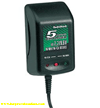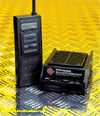Power, Sound, R/C
:
Battery
The Battery Car
Mar 26, 2003


By Paul Norton |
Author
Bio
The trailing car proved to be so reliable and easy to assemble, it quickly became our club's standard for battery power and radio control.
|
The Ottawa Valley GRS has not used track power on its club layout since the introduction of Bachmann's battery-powered Big Hauler more than thirteen years ago. As a result, our members have continuously experimented with on-board, battery power and radio control. When Aristo-Craft originally released their Train Engineer in 1995, they advertised it as the means to radio control an entire garden railway. One of our members, however, quickly realized its potential for on-board power. He connected the receiver to two, 9-volt, Ni-Cad, battery packs and placed them in an open gondola. When the gondola and receiver were coupled to a locomotive, it ran trouble free for almost two hours. The trailing car proved to be so reliable and easy to assemble, it quickly became our club's standard for battery power and radio control. 
Click for larger picture Over the years, boxcars, stockcars, and B units have been used successfully for trailing cars, but the cheapest and most practical is the covered gondola. Removing the snap on cover allows easy access to the receiver for programming and removal of the battery packs for charging. Replacing the cover hides the components and protects them from the elements. The ends of the gondola can also be folded down inside the car should ventilation be required for the receiver in extreme operating temperatures. To maximize reception, the receiver's antenna should be placed as high as possible in the car. The first photo shows the long antenna hot glued around the perimeter of the car walls. A wooden frame has been used to raise the height of the walls, so the cover will clear the receiver and 5-amp automotive fuse. 
Click for larger picture During the past twelve months, a couple of innovations have greatly increased the appeal of the battery car. Aristo-Craft's new plug & play diesels now come equipped with an IC socket to accept their new 75-mhz receiver, a switch to change between track and battery power as well as a battery car plug at each end. They also sell MU cables for battery car use. 
Click for larger picture The second innovation is the Nickel Metal Hydride (NiMH) battery pack. Although marketed for RC cars, it is ideal for large-scale trains. An NiMH pack is more expensive than a Ni-Cad pack, but provides much longer run times and can be topped up without being completely discharged. The Radio Shack on-line catalog currently shows a 3000-mah (3-amp hours), 7.2-volt pack (#230-0431) for $35 US. 
Click for larger picture The appropriate charger (#23-233) is $11 US. 
Click for larger picture
Although the new Aristo-Craft diesels have plug & play features, purchasing receivers for a fleet of locomotives can be expensive. Running a large locomotive like the SD-45 or a new A-B-A set of F-1s can also overheat the 75-mhz receiver. Several garden railroaders have solved this problem by removing the 10-amp, receiver (CRE-55471 formerly ART-5471) from its case and using it in a battery car. This unit is also less complicated to hook up than the mini-receiver is, as it comes with its own power switch and 10-amp fuse. During the months of March and April 2003, Aristo-Craft are offering a second the CRE-55471 receiver free with the purchase of the CRE-55470 Train Engineer set. 
Click for larger picture The following circuit diagram illustrates how simple it is to construct a battery car using the CRE-55471 receiver and a couple of Ni-Cad or NiMH battery packs. 
Click for larger picture If a 75-mhz mini receiver is substituted for the 10-amp receiver:
* a power switch should be installed in the red wire and
* a 5-amp fuse in the black wire between the input side of the receiver and the battery packs. Caution: Never plug an MU cable into a locomotive's battery car plug unless the receiver's power switch is off or the batteries are unplugged. Although it is possible to use a battery car with any large-scale locomotive, the track power pick-ups must be removed or wired to a switch to change between track power and battery power. Battery car plugs or MU cables also have to be correctly wired to the power distribution boards. As each type of locomotive and it's electrical circuitry is unique, it is impossible to accurately describe all the required procedures here.
Top of Page
|



